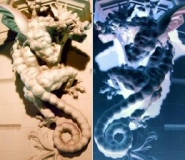Conveners
Parallel Session B. Neutrino mass mixing and CP-I
- Niki SAOULIDOU (Fermi National Accelerator Laboratory)
Prof.
Paul Kienle
(Excellence Cluster Universe, Technische Universität München)
13/12/2008, 15:00
Neutrino Mass, Mixing and CP
We have studied in a heavy ion storage ring at GSI Darmstadt, Germany the orbital electron capture decays of H-like 140Pr,142Pm and 122I ions and found that the time dependence of the electron capture rate is not exponential but time modulated with a period of T= 7.o6(8) s, 7.10(22) s and 6.04 s for 140Pr,142Pm and 122I, respectively, in the laboratory system of the ions moving with 071% of...
Igor Kreslo
(Laboratorium fuer Hochenergiephysik)
13/12/2008, 15:25
Neutrino Mass, Mixing and CP
The hypothesis of neutrino flavour changing in weak interaction representation via oscillations is
confirmed by several experiments, all based on the observation of the disappearance of a given neutrino flavour.
The direct appearance of a flavour different from the initial one, was never observed so far.
OPERA is the first long baseline neutrino oscillation experiment employing nuclear...
Dr
Inés Gil Botella
(Cent.de Investigac.Energeticas Medioambientales y Tecnol. (CIEMAT))
13/12/2008, 15:50
Experimental Prospects
The Double Chooz reactor neutrino experiment will be the next detector to search for a non vanishing q13 mixing angle with unprecedented sensitivity, which might open the way to unveiling CP violation in the leptonic sector. The measurement of this angle will be based in a precise comparison of the antineutrino spectrum at two identical detectors located at different distances from the Chooz...
Dr
Albert Villanova del Moral
(CFTP, Instituto Superior Técnico)
13/12/2008, 16:15
Supersymmetry
In minimal supergravity (mSugra), the neutrino sector is related to the slepton sector by means of the renormalization group equations. This opens a door to indirectly test the neutrino sector via measurements at LHC. Concretely, for the simplest seesaw type-I, we present the correlations between seesaw parameters and ratio of stau lepton flavour violating (LFV) branching ratios. We find some...
Ivo de Medeiros Varzielas
(CFTP, IST)
13/12/2008, 16:35
Neutrino Mass, Mixing and CP
We consider how, for quasi-degenerate neutrinos with tri-bi-maximal mixing
at a high energy scale, the mixing angles are affected by radiative running
from high to low-energy scales in a supersymmetric theory. The limits on the
high energy scale that follow from consistency with the observed mixing are
determined. We construct a model in which a non-Abelian discrete...
Dr
Stefano Morisi
(IFIC)
13/12/2008, 16:55
Family Symmetries
We suggest ways to model tri-bimaximal lepton mixing from first principles that avoid the problem of the vacuum alignment present in all models for tri-bimaximal mixing. This is achieved by using a single A4-triplet of Higgs scalars as well as three fermion triplets, and maintaining A4 as a symmetry of the full Lagrangian. The model realization we discuss is potentially testable at the LHC...
Juan C. D'Olivo
(Universidad de Mexico)
13/12/2008, 17:35
We present an analytical description of neutrino oscillations in matter based on the Magnus expansion of the time evolution operator. The approximated expressions obtained for the case of two neutrino mixing that propagate in the Earth potential, give considerably better results and in a wider energy range than the perturbative expressions existing in the literature. We apply our formalism to...
